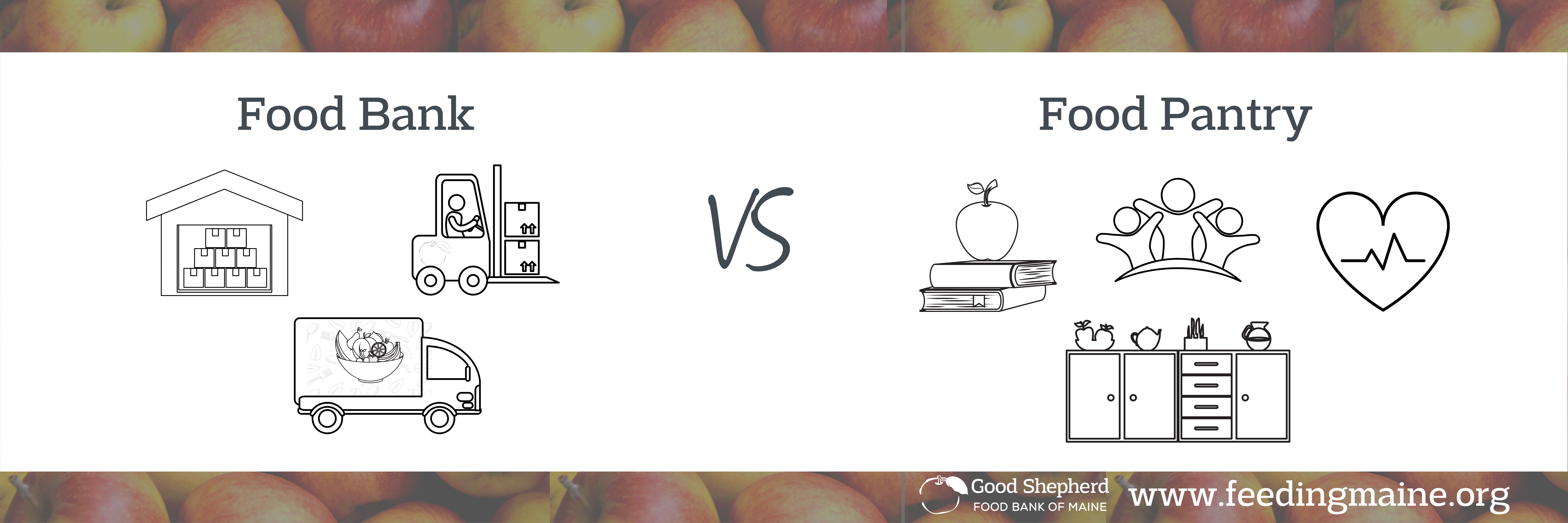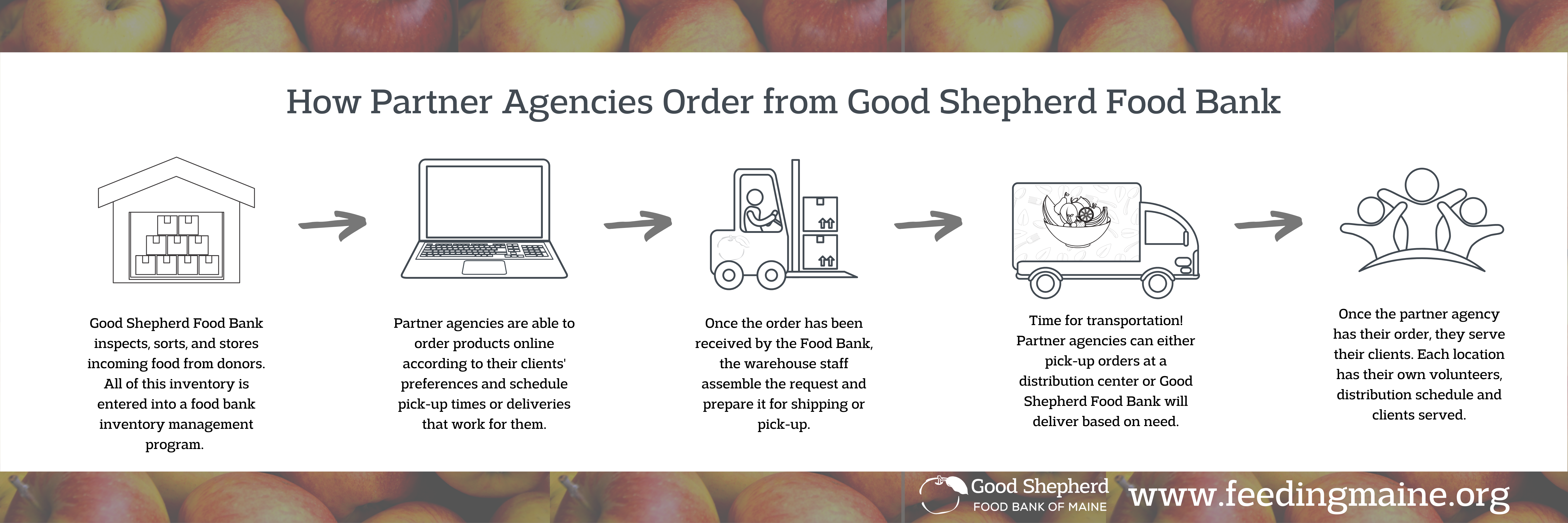Learn the difference between a Food Bank and a Food Pantry, and the partnership between them
Have you ever wondered what the difference is between a food bank and a food pantry? Even though both are directly related and have a strong partnership, each operates differently. Sometimes it’s easy to think that food banks distribute food directly to the public. However, a food bank is a warehouse and distribution center where food is sourced, received, inventoried, and distributed to food pantry partners and other hunger-relief agencies. At Good Shepherd Food Bank, we serve all 16 counties in Maine, from Kittery to Fort Kent, through our network of over 500 partner agencies, which include food pantries, meal sites, shelters, senior centers, healthcare facilities, and school programs.
We’ve broken down the differences below and provided more information about the work we do at Good Shepherd Food Bank of Maine.

Food Bank
A food bank is a non-profit warehouse and distribution center where food is solicited, received, safely inventoried, and distributed to local pantry partners. Food banks act as a grocery store of sorts for community partners and are responsible for ensuring that partners have the resources they need to feed those seeking help.
Food Pantry
A food pantry is an independent community site that distributes food and other products directly to those facing hunger. Food pantries are supplied with food by partnering with a local food bank, receiving donations from local grocery manufacturers, retailers, and food drives. Food pantries assist and help feed hundreds of people per week! Every community is different, and there are many different types of pantries. In Maine, we have local food pantries, meal sites, school food pantries, healthcare pantries in doctors’ offices up to large hospitals, and homeless shelters.
Learn more about Good Shepherd Food Bank of Maine

Established in 1981, Good Shepherd Food Bank is the largest hunger-relief organization in Maine. Providing Mainers facing hunger by distributing nutritious food to more than 500 partner agencies across the state, including food pantries, meal sites, school programs, healthcare facilities, and senior centers. The Food Bank has two distribution centers, a 53,000 square foot building in Auburn and a 40,000 square foot building in Hampden. To learn more about the Food Bank’s history, food distribution, sourcing, and warehouse space, go here.
Good Shepherd Food Bank of Maine is working on long-term solutions to break the cycle of poverty and food insecurity by offering these programs.
Donated Food – The majority of the food we distribute comes from donations from local and national food industry partners – grocery stores, manufacturers, and farms. Much of this food is rescued, meaning we are keeping food out of landfills and redirecting it to people in need.
Purchased Food – Purchased products are nutritious, staple items such as peanut butter, canned vegetables and beans, fresh and frozen meat, pasta, and rice. We purchase healthy food to supplement what we receive in donations.
Mainers Feeding Mainers – This program is the Food Bank’s collaboration with local farms to purchase and distribute nutritious, Maine-grown food. Each year, the Food Bank makes purchases of fresh Maine vegetables, fruits, dairy products, and fish for our partner agencies. The Food Bank also receives donations from many local farmers. In 2020, we partnered with over 80 Maine farms to distribute two million pounds of local foods and invested $750,000 into Maine’s agricultural sector.
Food Mobile – The Food Bank operates a mobile food pantry to reach underserved areas of the state. In 2019, the Food Bank distributed 120,000 pounds of food through 40 Food Mobile deliveries in all 16 counties.
Community Health & Hunger – The Food Bank partners with healthcare partners to implement the Hunger Vital Signs Food Insecurity Screening questions as part of patient visits. Patients who identify as needing improved access to healthy food can be provided with emergency assistance bags, from the Food Bank, packed with nutrition-dense food. Patients are also connected to community resources, like food pantries, where they can have regular access to healthy foods.
In 2020, the Food Bank on boarded thirty-seven new partners, distributed over 210,000 pounds of food, including 71,000 pounds of fresh produce, and doubled the number of households served.
Youth & Family Initiatives – The Food Bank operates the School Pantry program to combat child hunger by providing food to children for weekends and school vacations and to be able to reach families in need through school connections. In addition, we operate an afterschool meal and snack program called Kids Café and a Summer Lunch program in Bangor & Brewer. In 2020, we partnered with 233 school-based programs across the state and served 2.9 million meals to more than 23,800 families statewide through our Youth & Family programs. 93% of youth and family programs remained operational in some capacity during the school year, continuing to serve our communities, despite the pandemic.
Cooking Matters Maine – Cooking Matters Maine is an outreach program that mobilizes culinary and nutrition professionals to teach cooking and nutrition classes to low-income adults, teens, and children. Classes are taught at local community centers, schools, and food pantries and provide people at risk of hunger with hands-on cooking and nutrition experience. In 2020, we offered 124 Cooking Matters classes and 129 store tours to 2,521 participants.
USDA Commodity Programs – The Emergency Food Assistance Program (TEFAP) and The Commodity Supplemental Food Program (CSFP) are federal programs that helps supplement the diets of low-income needy persons, including the elderly, by providing them with emergency food and nutrition assistance. The Food Bank administers these programs for the government.
Service Insights Initiative – Good Shepherd Food Bank believes the more we know about people experiencing hunger in our network, the more effectively we can measure our impact, allocate resources, and successfully advocate on their behalf. Starting in 2018, we recruit partner agencies to use Link2Feed, a web-based software, to record information about their clients and the services they provide. We currently have participants representing all sixteen counties in Maine and are always looking to expand our network!
Building Advocates Leadership Program (BALP) – This program strengthens, uplifts, and integrates voices of community members who are struggling with food insecurity into a statewide advocacy movement to end hunger. Throughout the program, participants build an active community, strengthening their skills in public speaking, and learn how to use their personal stories as tools for change.
For more information on Good Shepherd Food Bank of Maine, visit feedingmaine.org.